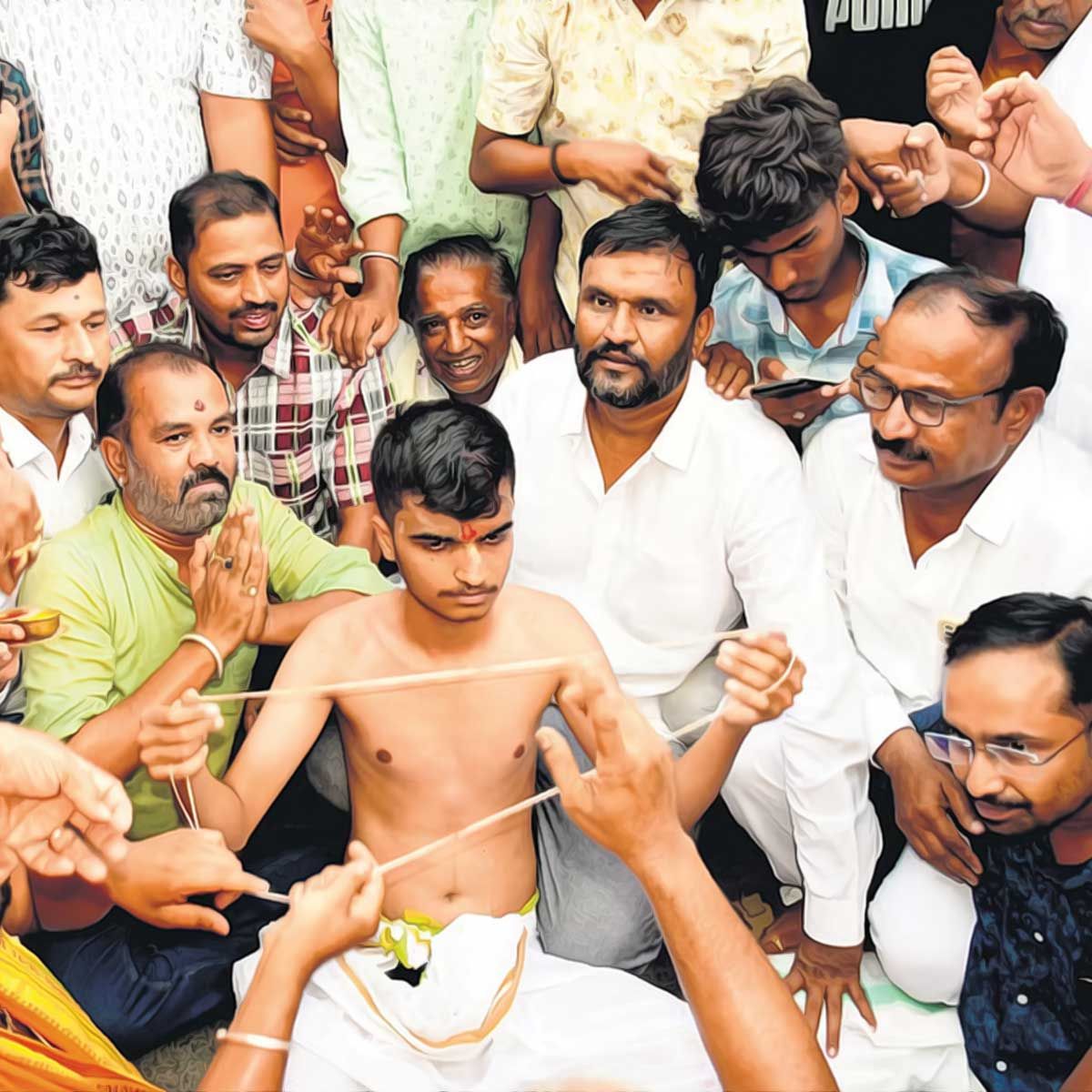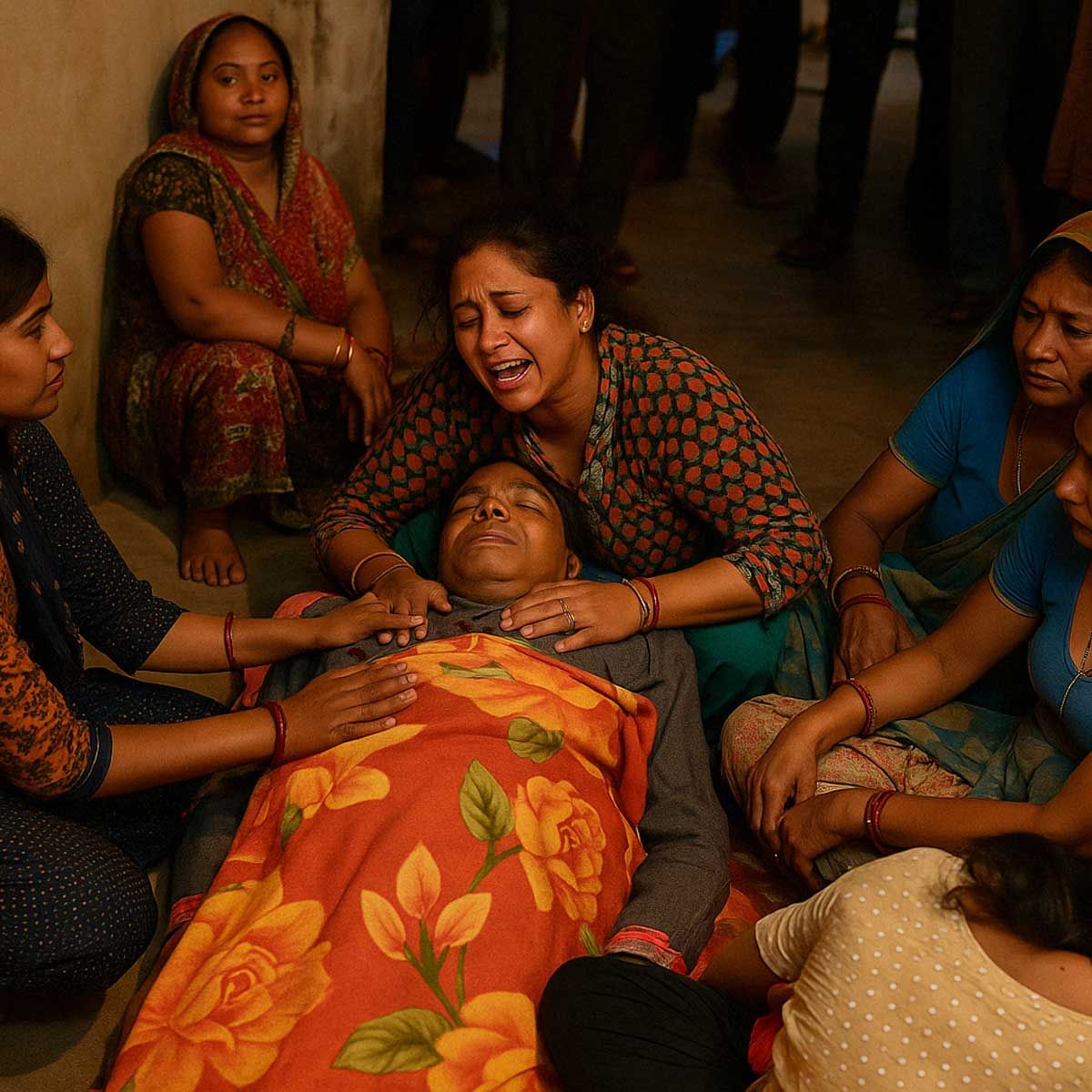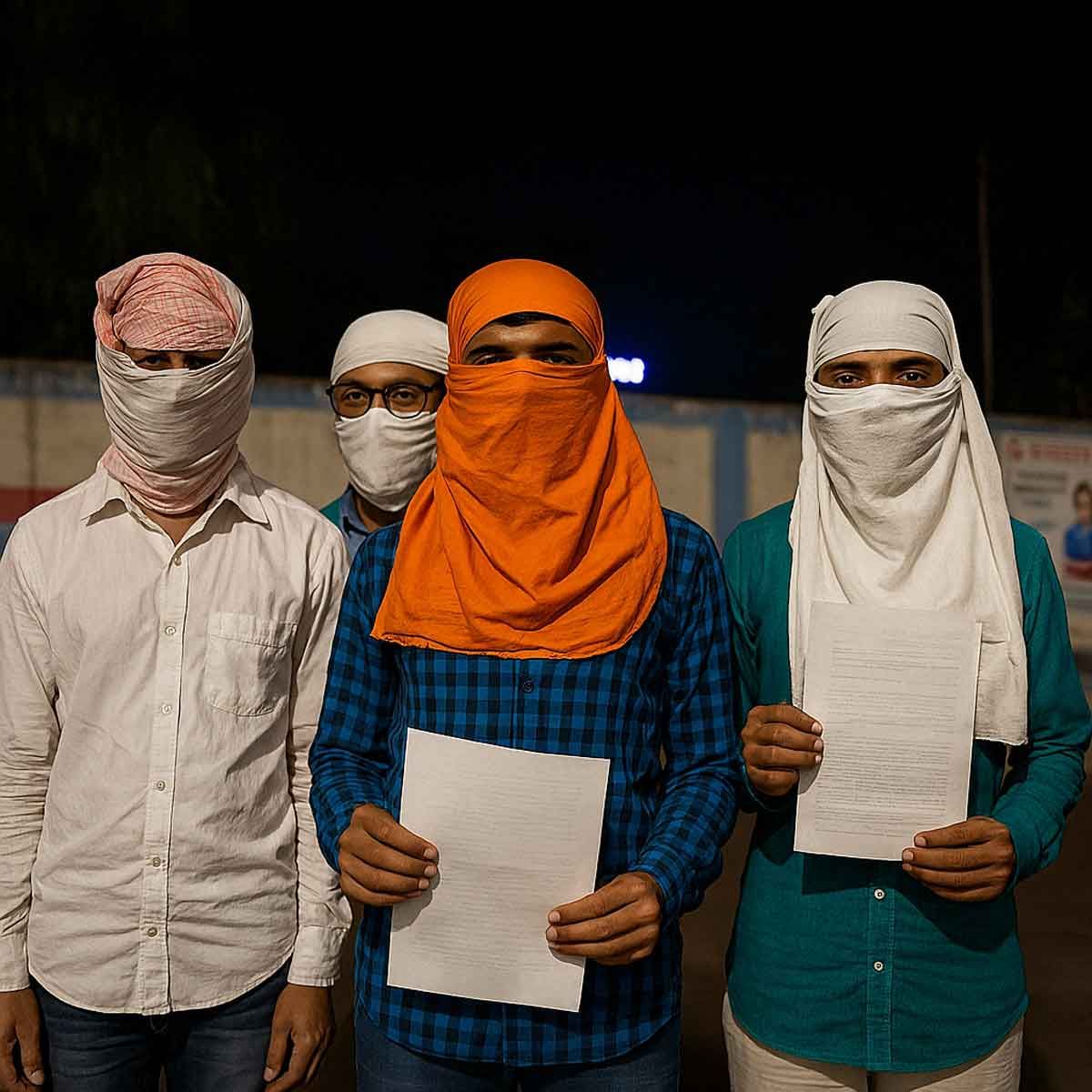More Coverage
Twitter Coverage
Satyaagrah
Written on
Satyaagrah
Written on
Satyaagrah
Written on
Satyaagrah
Written on
Satyaagrah
Written on
JOIN SATYAAGRAH SOCIAL MEDIA
"शिव तांडव": Gujarat’s 2024 massive demolition drive, with 58 bulldozers, 10 dumpers, 1,400 personnel, and high-ranking officials, cleared illegal structures, including a mosque and a 500-year-old graveyard near Somnath Temple, reclaiming 15 hectares

In a decisive action aimed at reclaiming government land, the Gujarat administration carried out a large-scale demolition drive on 28th September 2024, targeting illegal religious structures, including a mosque, a 500-year-old graveyard, and several dargahs near the sacred Somnath Temple. This move has drawn both praise and criticism, but it is undeniable that the Gujarat government took a firm stand against unlawful encroachments that had plagued this region for years.
The magnitude of this operation was staggering, with 135 individuals detained as part of the drive, a clear signal of the administration’s intent to restore law and order in the area. 36 JCBs, 70 tractors, 5 Hitachi machines, 10 dumpers, 58 bulldozers, and two hydra cranes were put into action, demonstrating the sheer scale of the equipment mobilized for the operation. To further ensure smooth execution, two ambulances and three fire trucks were on standby, while an army of 1,400 police officers was deployed to provide security.
One cannot overlook the meticulous planning that went into this operation. The Gujarat administration ensured that high-ranking officials like district collectors, IGPs, three SPs, six DySPs, and 50 PI-PSIs oversaw the demolition, maintaining a strict and secure environment. Such a robust response indicates a well-thought-out strategy aimed at eliminating illegal encroachments that had long overshadowed the grandeur of the Somnath Temple.
The Gujarat government’s commitment to enforcing law and reclaiming illegally occupied land sends a powerful message to those who might seek to exploit government property for religious or other purposes. The presence of these illegal structures had not only disrupted the serenity of the region but also disrespected the sanctity of one of India’s most revered temples.
|
Bold action deserves bold praise, and in this case, the Gujarat administration has rightfully earned commendation for its dedication to upholding the law. It is a stark reminder that no matter how old or religiously significant a structure might be, illegal encroachment cannot be tolerated in any form. The presence of unauthorized religious sites near a place as holy as Somnath Temple was a blatant overreach, and the government’s swift action proves its unwillingness to bow down to pressure from any illegal groups or communities.
While some may argue about the sentimental or religious significance of the demolished structures, the fact remains that laws must be upheld. Encroachment of government land is a violation, regardless of who commits it, and in this case, it is the Muslim community that must face the consequences of erecting illegal structures near a historically significant and religious site.
The Gujarat government’s handling of this situation has set a precedent for other states to follow. It shows that with enough resolve, even long-standing illegal structures, such as a 500-year-old graveyard, can be removed in favor of maintaining order and lawfulness.
The Gujarat government continued its resolute effort to remove illegal encroachments in the revered Prabhas Patan area near the Somnath Mandir, deploying a staggering number of resources to ensure the operation was carried out efficiently. Thanks to the meticulous planning by the authorities, the law and order situation remained controlled throughout the operation, with no significant incidents reported. This reflects the administration’s thorough preparation and firm stance on handling such sensitive operations without allowing any disruptions.
The demolition drive was in direct response to the unlawful construction of religious structures and other encroachments that had emerged in Prabhas Patan, a region of profound religious significance located in the Gir Somnath district. Close to the sacred Somnath Mandir, these illegal constructions had long been a thorn in the side of the administration, prompting the government to take action to restore the integrity of the region.
The scope of the operation was vast, with hundreds of police personnel deployed to remove the unauthorized structures in Prabhas Patan, Veraval. According to the district administration, the demolition drive targeted both religious structures and concrete houses, clearing the illegally occupied land in an early morning operation. The results of this effort were monumental, with approximately 15 hectares of land being freed, a portion of land valued at around Rs 60 crore. This not only reinstates the government's control over the area but also opens up opportunities for lawful development and preservation of the region’s sanctity.
A significant number of people from the minority community had gathered to witness the demolition, as JCBs and other machines were brought in to raze down the illegal structures. Despite the presence of a crowd and the tensions that could have arisen from such an event, the operation was conducted in an atmosphere of peace and harmony. However, authorities remained vigilant, detaining over 135 people who were involved in protests or found wandering in restricted areas. Their swift actions ensured that there was no major disruption, and the operation could be completed without significant issues.
The involvement of senior officials during the demolition was crucial in maintaining the orderly proceedings. On-site, the district collector, IG, three SPs, six DySPs, and fifty police inspectors and sub-inspectors were present, further highlighting the seriousness with which the Gujarat government approached this matter. Their presence not only ensured that the operation was executed efficiently but also helped manage any potential backlash or unrest during the event.
A video shared by the official X account of ‘The Observer Post’, which describes itself as an ‘Independent media organisation,’ captured the demolition in progress. The video showed bulldozers demolishing mosques, graveyards, and dargahs in Prabhas Patan, Veraval, a striking visual of the government’s commitment to reclaiming illegally occupied land near the historic Somnath Temple.
The demolition of illegal religious structures near Somnath Temple began early in the morning, at around 4 am, marking the continuation of a strict approach by the Gujarat administration in reclaiming government land. The construction of such unauthorized structures has been a recurring issue in the state, especially in coastal regions like Somnath, which bears significant historical and religious importance. This area has a long and painful history of being the target of Islamist invasions, notably by Mahmud of Ghazni, who raided the Somnath Temple with the intent of humiliating the Hindu community.
Mahmud’s attack on Somnath was more than just an act of plunder. He sought to desecrate the religious symbol of Hindus, and he did so by breaking the idol of the presiding deity into four pieces. This act was intended to demonstrate his dominance. The four pieces of the shattered idol were then sent to different locations, each with a specific purpose to further this degradation. One piece was taken by Mahmud to Ghazni in Afghanistan, where it was deposited at the entrance of the Jama Masjid of Ghazni. Another piece was placed at the court door of his palace as a trophy of his conquest. The other two fragments were reportedly sent to Mecca and Medina, where they were buried inside mosques, further intensifying the humiliation for the Hindu community. This act of religious violence was a profound insult not just to the temple but to the very fabric of Hindu worship.
The legendary loot of Somnath Temple did not stop with Mahmud of Ghazni. His raid on the temple opened the floodgates for other Islamic marauders, who descended on the temple and other religious centers across the region. These included other sacred places like Dwarka, Girnar, and several other sites of religious significance for Hindus, Jains, and various other communities. These locations, much like Somnath, were not only places of worship but also thriving centers of trade and spirituality. As trade routes connected these religious sites to distant lands, settlers from various parts of the world began to establish themselves in these areas, bringing both prosperity and, unfortunately, a wave of illegal constructions that would soon mar the sanctity of these regions.
Over time, these settlers contributed to the rise of illegal structures that mushroomed near religious shrines, creating a serious issue for the Gujarat administration. These unauthorized constructions not only violated the law but also encroached on lands that held deep spiritual and cultural significance for local communities. Recognizing the gravity of the situation, the Gujarat government has consistently undertaken demolition drives to restore order and reclaim government lands that have been encroached upon illegally. Some of the major coastal regions where these operations have been carried out include Bet Dwarka, Porbandar, and Jamnagar.
In these regions, the Gujarat administration’s focus has not only been on removing encroachments but also on cracking down on various illegal activities that have plagued these areas. Alongside the encroachment of religious sites, there have been numerous cases of land grabbing, where individuals or groups unlawfully seized land for their own benefit. Furthermore, these coastal regions, especially those with illegal encroachments, have become hubs for other illicit activities. The government’s operations have specifically targeted drug trafficking, smuggling, and other activities that pose a direct threat to national security. These illegal acts, often concealed under the guise of religious encroachments, have made it necessary for the administration to act decisively.
In the interest of maintaining public safety, the Gujarat administration has cordoned off the entire demolition site, restricting access strictly to authorized personnel. To further facilitate the smooth progress of the operation, traffic management measures have been put in place. Key routes, including those at Somnath Circle and Bhidiya Circle, have been closed to prevent any disruptions and ensure that the demolition process continues without hindrance.
As the demolition of illegal encroachments progresses, attention is turning toward its potential impact on the overall landscape of Gir Somnath. This large-scale removal of unauthorized structures is expected to significantly influence the ongoing Somnath Development Project, which aims to enhance the region's infrastructure and cultural value. While the immediate goal is to clear the land, the long-term effects will likely reshape how the district looks and operates, especially in light of the revered Somnath Temple being a focal point of religious pilgrimage and tourism.
Earlier this year, in January 2024, Gujarat authorities had launched another major anti-encroachment operation, targeting approximately three hectares (7.4 acres) of illegally occupied land situated behind the Somnath Temple in the Gir Somnath district. This operation was part of a broader effort to reclaim land that had been unlawfully taken over and restore it to its rightful owners, in this case, the Shree Somnath Trust, which manages the operations of the temple in coordination with the Gujarat government.
According to Collector Harji Vadhvaniya, the operation focused on demolishing 21 unauthorized houses and 153 illegal huts, all of which had been constructed on land that legally belongs to the Somnath Trust. These structures were erected without any permission, encroaching on the trust's land, which is considered highly sacred due to its proximity to the Somnath Temple. The temple holds immense cultural and religious significance not just for Gujarat but for India as a whole.
To ensure the success of the demolition drive, the Gujarat administration deployed a robust team, consisting of five mamlatdars (revenue officers) and approximately 100 revenue officials. Additionally, a considerable police force was present to maintain peace and order during the operation. Following the successful clearance of the encroachments, authorities have planned to fence the reclaimed three-hectare area, a move that aligns with directives issued by the state’s revenue department. The fencing of the land is seen as a proactive measure to protect it from further violations and ensure that it remains under the rightful stewardship of the Shree Somnath Trust.
The Somnath Temple, located in Prabhas Patan near Veraval town along the Arabian Sea coast, is considered one of India’s most important religious and cultural landmarks. As the foremost of the 12 jyotirlinga shrines dedicated to Lord Shiva, the temple attracts millions of pilgrims and tourists every year. Its significance stretches back centuries, making it not only a key religious site but also a major cultural and historical treasure. The ongoing demolition drive and efforts to reclaim the surrounding land are crucial steps toward preserving this heritage and ensuring that the temple remains a beacon of faith and culture for generations to come.
 |
 Support Us
Support Us
Satyagraha was born from the heart of our land, with an undying aim to unveil the true essence of Bharat. It seeks to illuminate the hidden tales of our valiant freedom fighters and the rich chronicles that haven't yet sung their complete melody in the mainstream.
While platforms like NDTV and 'The Wire' effortlessly garner funds under the banner of safeguarding democracy, we at Satyagraha walk a different path. Our strength and resonance come from you. In this journey to weave a stronger Bharat, every little contribution amplifies our voice. Let's come together, contribute as you can, and champion the true spirit of our nation.
 |  |  |
| ICICI Bank of Satyaagrah | Razorpay Bank of Satyaagrah | PayPal Bank of Satyaagrah - For International Payments |
If all above doesn't work, then try the LINK below:
Please share the article on other platforms
DISCLAIMER: The author is solely responsible for the views expressed in this article. The author carries the responsibility for citing and/or licensing of images utilized within the text. The website also frequently uses non-commercial images for representational purposes only in line with the article. We are not responsible for the authenticity of such images. If some images have a copyright issue, we request the person/entity to contact us at This email address is being protected from spambots. You need JavaScript enabled to view it. and we will take the necessary actions to resolve the issue.
Related Articles
- Gujarat’s demolition drive under Bhupendra Patel reclaims ₹15 crore worth of GMB land, demolishes Hazrat Panj Pir Dargah, clears 4,000 sq.ft. on Pirotan Island, removes 9 illegal structures, targets NDPS risks, and secures Bet Dwarka’s faith & marine life
- Madhya Pradesh HC accepted petition for stay on Muslims performing Namaz in the compound of Bhojshala monument: Read how an educational centre and a historic temple of Goddess Saraswati became Kamal Maulana mosque
- Criticizing Varanasi court Asaduddin Owaisi spreads hate again, says court paving way for ‘anti-Muslim violence’ with the survey of disputed structure ‘Gyanvapi Mosque’ premises
- Iconic Shivlinga rose above smog of denial after centuries and so have documents validating temple existence in same place: layout of old Vishveshwar temple and what British historians said about the structure
- In a major development, Mathura court allowed a plea to remove the disputed structure of the Shahi Idgah Mosque near Krishna Janmabhoomi for hearing: suit filed in the name of "Bhagwan Sri Krishna Virajman"
- 'Found stone carvings of Hindu Gods-Goddesses, lotus, Seshnaag, Shrigar Gauri shrine distinctly visible, absolute remnants of ancient Hindu temple': Survey commissioner Ajay Mishra reports, Muslim side continuously uncooperative
- 1200 years old rarest idol of Lord Narasimha and devotee Prahlada identified in Qutub Minar complex by renowned archaeologist Dharamveer Sharma: special attraction for religious and researching community
- Videography of Gyanvapi Mosque to go ahead today amid tight security: Mosque committee in Varanasi had earlier opposed the survey, said 'no non-believer will be allowed to enter the mosque
- "कल्कि": Sambhal, the prophesied birthplace of Kalki Avatar, saw Harihar Mandir fall between Balban’s 1254 massacre and Sikandar Lodhi’s rule, as Carlleyle’s 1879 ASI report exposed temple remains beneath Shahi Jama Masjid, rewriting history
- Idols of Hindu deities, including Hanuman and Ganesha found lying in the debris in Gujarat’s Vadodara, Mayor Keyur Rokadia performs pooja, assures to re-establish them
- Does the Places of Worship Act 1991, really forbids any transformation in worship’s religious character after August 15, 1947? Gyanvapi compound may lead to its exemption if found more than 100 years old
- All India Hindu Mahasabha seeks permission to consecrate Laddu Gopal at Shahi Idgah masjid next to Sri Krishna Janmabhoomi in Mathura, court admits plea
- Delhi's Akhoondji Masjid and Behrul Uloom madrasa in Mehrauli, dating back 600-700 years, demolished by the DDA, sparking outrage, Delhi Waqf Board contests the legality; the Delhi High Court demands DDA's explanation for razing the historic structures
- Telangana BJP MLA Raja Singh wrote to the Archaeological Survey of India for the removal of a Dargah constructed within Jogulamba temple premises, it’s a Shaktipeeth where Maa Sati’s upper teeth fell
- Hours after Shivling discovered inside disputed Gyanvapi, AIMIM chief Asaduddin Owaisi provokes Muslims against court-ordered proceedings amidst chants of ‘Naara-e-Takbeer’ and ‘Allahu Akbar




























